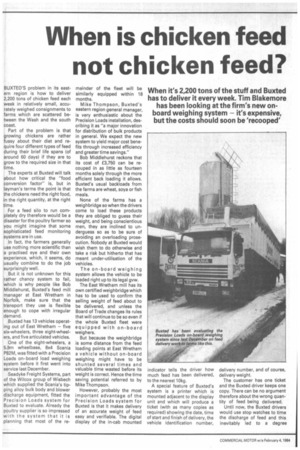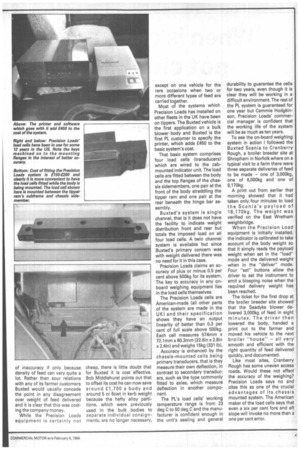When is chicken feed not chicken feed?
Page 42

Page 43

If you've noticed an error in this article please click here to report it so we can fix it.
When it's 2,200 tons of the stuff and Buxted has to deliver it every week. Tim Blakemore has been looking at the firm's new onboard weighing system — it's expensive, but the costs should soon be 'recooped'
BUXTED'S problem in its eastern region is how to deliver 2,200 tons of chicken feed each week in relatively small, accurately weighed consignments to farms which are scattered between the Wash and the south coast.
Part of the problem is that growing chickens are rather fussy about their diet and require four different types of feed during their brief life spans (of around 60 days) if they are to grow to the required size in that time.
The experts at Buxted will talk about how critical the "food conversion factor" is, but in layman's terms the point is that the chickens need the right food, in the right quantity, at the right time For a feed silo to run completely dry therefore would be a disaster for the poultry farmer so you might imagine that some sophisticated feed monitoring systems are in use.
In fact, the farmers generally use nothing more scientific than a practised eye and their own experience, which, it seems, do usually combine to do the job surprisingly well.
But it is not unknown for this rather chancy system to fail, which is why people like Bob Middlehurst, Buxted's feed mill manager at East Wretham in Norfolk, make sure that the transport they use is flexible enough to cope with irregular demand.
Buxted has 13 vehicles operating out of East Wretham — five six-wheelers, three eight-wheelers, and five articulated vehicles.
One of the eight-wheelers, a 5.9m wheelbase, 8x4 Scania P82M, was fitted with a Precision Loads on-board load weighing system before it first went into service last December.
Seadyke Freight Systems, part of the Wilcox group of Wisbech which supplied the Scania's tipping alloy bulk body and blower discharge equipment, fitted the Precision Loads system for Buxted to evaluate. Already the poultry supplier is so impressed with the system that it is planning that most of the re
mainder of the fleet will be similarly equipped within 18 months.
Mike Thompson, Buxted's eastern region general manager, is very enthusiastic about the Precision Loads installation, describing it as "a major innovation for distribution of bulk products in general. We expect the new system to yield major cost benefits through increased efficiency and greater time savings."
Bob Middlehurst reckons that its cost of £3,750 can be recouped in as little as fourteen months solely through the more efficient back loading it allows. Buxted's usual backloads from the farms are wheat, soya or fish meals.
None of the farms has a weighbridge so when the drivers come to load these products they are obliged to guess their weight, and being conscientious men, they are inclined to underguess so as to be sure of avoiding an overloading prosecution. Nobody at Buxted would wish them to do otherwise and take a risk but hitherto that has meant under-utilisation of the vehicles.
The on-board weighing system allows the vehicle to be loaded right up to its legal gvw.
The East Wretham mill has its own certified weighbridge which has to be used to confirm the selling weight of feed about to be delivered, and unless the Board of Trade changes its rules that will continue to be so even if the whole Buxted fleet were equipped with on-board we But because the weighbridge is some distance from the feed loading points at East Wretham a vehicle without on-board weighing might have to be shunted several times and valuable time wasted before its weight is correct, Hence the time saving potential referred to by Mike Thompson.
However, probably the most important advantage of the Precision Loads system for Buxted is that it makes delivery of an accurate weight of feed easy and verifiable. The digital display of the in-cab mounted indicator tells the driver how much feed has been delivered, to the nearest 10kg.
A special feature of Buxted's system is a printer whi.ch is mounted adjacent to the display unit and which will produce a ticket (with as many copies as required) showing the date, time of start and finish of delivery, the vehicle identification number, delivery number, and of course, delivery weight.
The customer has one ticket and the Buxted driver keeps one copy. There can be no argument therefore about the wrong quantity of feed being delivered.
Until now, the Buxted drivers would use stop watches to time the discharge of feed and this inevitably led to a degree of inaccuracy if only because density of feed can vary quite a lot. Rather than sour relations with any of its farmer customers Buxted would usually concede the point in any disagreement over weight of feed delivered and it is clear that this was costing the company money.
While the Precision Loads equipment is certainly not cheap, there is little doubt that for Buxted it is cost effective. Bob Middlehurst points out that to offset its cost he can now save around £1,700 a body and around 5 or 6cwt in kerb weight because the hefty alloy partitions, which were previously used in the bulk bodies to separate individual consignments, are no longer necessary, except on one vehicle for the rare occasions when two or more different types of feed are carried together. Most of the systems which Precision Loads has installed on other fleets in the UK have been on tippers. The Buxted vehicle is the first application on a bulk blower body and Buxted is the first PL customer to specify the printer, which adds £450 to the basic system's cost.
That basic system comprises four load cells (transducers) which are wired to the cabmounted indicator unit. The load cells are fitted between the body and the top flanges of the chassis sidemembers, one pair at the front of the body straddling the tipper ram and one pair at the rear beneath the hinge bar assembly.
Buxted's system is single channel, that is it does not have the facility to indicate weight distribution front and rear but totals the imposed load on all four load cells. A twin channel system is available but since Buxted's primary concern was with weight delivered there was no need for it in this case.
Precision Loads claims an accuracy of plus or minus 0.5 per cent above 500kg for its system. The key to accuracy in any onboard weighing equipment lies in the load cells themselves.
The Precision Loads cells are American-made (all other parts of the system are made in the UK) and their specification shows they have an output linearity of better than 0.3 per cent of full scale above 500kg. Each cell measures 574mm x 72.1mm x 60.3mm (22.6in x 2.8in x 2.4in) and weighs 15kg (331 lb).
Accuracy is enhanced by the chassis-mounted cells being primary transducers, that is they measure their own deflection, in contrast to secondary transducers, such as the type commonly fitted to axles, which measure deflection in another component.
The PL's load cells' working temperature range is from 23 deg C to 50 deg C and the manufacturer is confident enough in the unit's sealing and general durability to guarantee the cells for two years, even though it is clear they will be working in a difficult environment. The rest of the PL system is guaranteed for one year but Cammie Hodgkinson, Precision Loads' commercial manager is confident that the working life of the system will be as much as ten years.
To see the on-board weighing system in action I followed the Buxted Scania to Cranberry Rough, a broiler breeder site at Shropham in Norfolk where on a typical visit to a farm there were three separate deliveries of feed to be made — one of 3,000kg, one of 6,000kg and one of 9,170kg.
A print out from earlier that morning showed that it had taken only four minutes to load the Scania's payload of 18,170kg. The weight was verified on the East Wretham weighbridge.
When the Precision Load equipment is initially installed, the indicator is calibrated to take account of the body weight so that it simply reads the payload weight when set in the "load" mode and the delivered weight when in the "deliver" mode. Four "set" buttons allow the driver to set the instrument to emit a bleeping noise when the required delivery weight has been reached.
The ticket for the first drop at the broiler breeder site showed that the Seadyke blower delivered 3,000kg of feed in eight minutes. The driver then lowered the body, handed a print out to the farmer and moved his vehicle to the next broiler "house" — all very smooth and efficient with the right quantity of feed delivered quickly, and documented.
Like most sites, Cranberry Rough has some uneven access roads. Would these not affect the accuracy of the weighing? Precision Loads says no and cites this as one of the crucial advantages of its chassis mounted system. The American maker of the load cells says that even a six per cent fore and aft slope will invoke no more than a one per cent error.
































































































